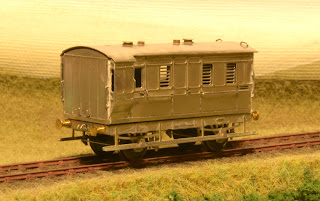In recent weeks (months?) I've been working on the station building for Corrieshalloch. The styrene shell was covered in a layer of Fimo air drying clay (similar to DAS), glued on with PVA. Once dry, I carved the stonework courses using a needle held in a pin vice. The clock face (between the bottom left windows) is made from a short length of brass tube set in the wall and filled with filler.
The roof is a separate, removable unit. It has a basic structure of styrene with slates made from strips of paper, as for the goods shed. Slating was a little tedious owing to the three dormer windows and many angled cuts required. Microstrip was used to create the guttering and fascia boards around the outside. The chimneys are covered in clay like the main walls of the building.
The chimney pots are quite exciting (for me) as they are turned brass, and are the first items that I've made on my lathe (a Sherline). I was pleasantly surprised with how easy this was. I had to grind a left-handed turning tool (from 1/8" HSS bar), as the lathe only came with a right-handed tool and I needed to get into both sides of the bits that stick out (technical term?). I wasn't sure whether I could do this grinding operation on my little LIDL bench grinder, but it worked a treat. It actually took me a few months to work up the confidence to try making something on the lathe, but I needn't have worried and I'm looking forward to finding uses for it in future. It was quite fun trying to puzzle out the best order in which to make the cuts (the chimneys also have integral spigots for fitting in the roof). I don't have a parting tool so simply cut them off with a piercing saw. I think the results are at least better than the white-metal castings that I have in the drawer (and used for the goods shed).










